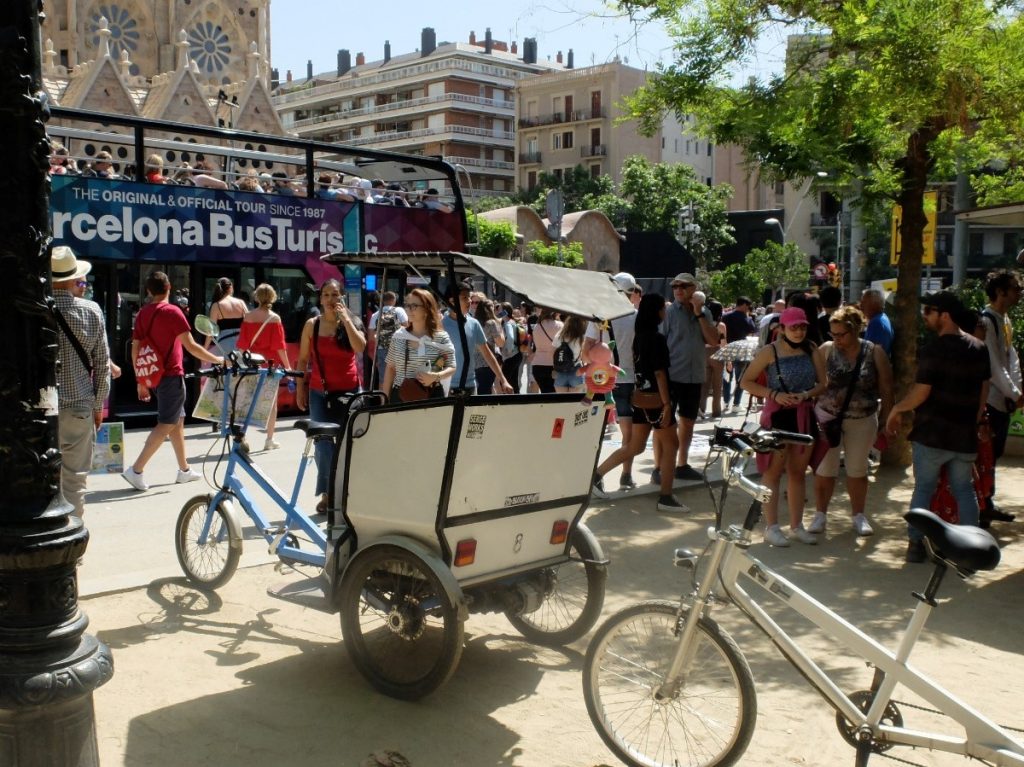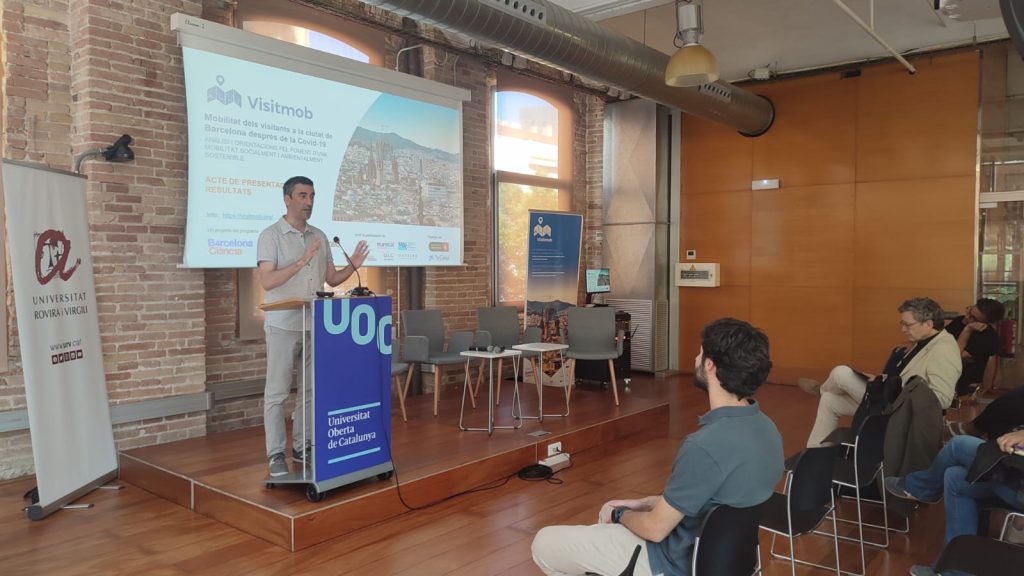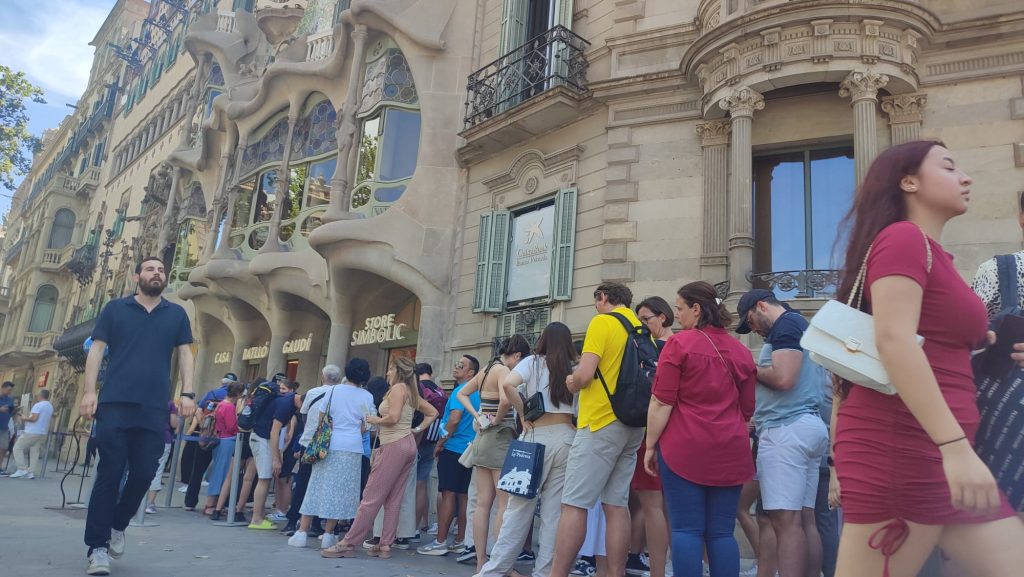06/06/2023
Barcelona residents and cruise passengers agree that the city is overcrowded
The Universitat Rovira i Virgili has published the results of the largest study to date on the mobility patterns of people visiting Barcelona and how their presence affects the local people

The Universitat Rovira i Virgili has published the results of the largest study to date on the mobility patterns of people visiting Barcelona and how their presence affects the local people
More than half of the cruise tourists consider that there are too many people in Barcelona. They largely agree with the local population who live alongside this tourism and point out that the concentration of visitors around the main tourist areas of the city affects their daily commutes and their quality of life, to the point that they now avoid or have stopped visiting some areas. These are some of the results of the VISITMOB project, the most extensive study to date on the urban mobility of people visiting Barcelona and the effects they have on the local population. The project has been led by the GRATET research group of the Universitat Rovira i Virgili (URV), headed by the researcher from the Department of Geography Aaron Gutiérrez, who presented the main conclusions this Tuesday in Barcelona.
The data were obtained from the responses of nearly 4,000 surveys of various groups: tourists who spend the night in Barcelona, others who spend the day there, people who take advantage of a visit to the city to go sightseeing and also cruise passengers, who were fitted with a geolocation device to monitor their movements during the average five hours they spend visiting the city between leaving and returning to the port. As part of this study, the local population has been given 2,000 surveys and a sample has been given in-depth interviews to assess the extent to which their daily mobility is affected by all this tourist activity and if – and how – it affects quality of life.
All this information has given an unprecedently detailed picture, which has identified the challenges that need to be overcome to plan a more sustainable social and environmental mobility, and proposed instruments that will enable it to be put into practice.
The project led by the URV was funded by Barcelona City Council and Fundació la Caixa as part of the Barcelona Science 2020-2023 plan. Researchers from the Open University of Catalonia (UOC), the Global Health Institute of Barcelona (ISGlobal), the International University of Catalonia (UIC Barcelona), the Ostelea Tourism Management School and Eurecat’s CoE Tourist Innovation have taken part.

Concentration of visitors that fuel the perception of overcrowding
Although 90% of the cruise tourists interviewed defined their experience visiting the city as pleasant and 80% felt safe there, more than half – 53% – pointed out there were too many people to fully enjoy the places they visited and only 58% consider that there are enough places to sit and rest during their stay.
The problem of overcrowding is also mentioned by the local population. A total of 36.2% state that mobility in the public space is conditioned by tourist activity, which also affects the comfort of the public transport service (28.5%) and its punctuality (25.6%). These figures increase by up to 10 points for people who live in tourist districts.
The answers to the surveys by visitors and one-day sightseers, as well as the geolocation system used by the cruise passengers, showed that the space-time concentration is very high at some points in the city. The Ciutat Vella district is visited by 100% of cruise passengers with an average stay of two hours, of which 1.15 hours are spent on foot. Then come the Eixample and Gràcia. Districts. Neither Nou Barris or Sant Andreu are visited by any cruise passengers.
The data also point to a clear concentration at certain iconic places in the city. The greatest concentration of cruise passengers is around the Rambles (96.7%), Plaça de Catalunya, Passeig de Gràcia (73%) and the Sagrada Família (63.1%). Thus, the Rambles is the space where tourists and sightseers coincide with nearly 34%, but only 23% of day visitors from outside Barcelona go there.
Of all the cruise tourists interviewed, half had already visited Barcelona before and, of these, 78% repeat the same route. “Regardless of the type of people, their age or the type of trip they take, the study shows that most tourists and visitors frequent the same places. This has to do with the preconceived ideas they have about the city and what you are supposed to do when you go to Barcelona”, explains Gutiérrez.

Change of routines and uprooting
The study reveals that the presence of tourists generates dissatisfaction for 23% of residents when moving around the city, affects their choice of transport and prevents their visiting certain places. These changes in mobility patterns have been observed mainly in men, older people, people from the highest and lowest socio-economic level and the residents of tourist districts. “The lack of places for meeting, recreation or children’s leisure is one of the main features of the interviews with mothers and fathers, who also warn of the risks caused by the waste generated by nightlife, especially glass and street parties”, explains researcher Aaron Gutiérrez.
The results of the study warn that the effects of mass tourism not only generate a daily problem for the locals but also lead to a loss of feeling of belonging to the place where they live. This feeling of uprooting is accentuated in the elderly, who are more sensitive to the changes that have taken place in the last twenty years, according to the study. “Many of these changes are no longer perceived as an exceptional event of the summer season: the overcrowding has become chronic throughout the year, especially in the Gothic District and around the Sagrada Família,” adds Gutiérrez.
The percentages are similar for the quality of life of the locals. The presence of tourists negatively affects the quality of life of 17% of the people interviewed, a figure that increases by 6 points among the residents of tourist districts.
Patterns of sustainable mobility
Despite the negative impact generated by the spatial concentration of people flows, the research team points out that the most sustainable tourist mobility patterns in the city – walking or public transport – are those most often used. “Approximately 80% of trips are made on foot and, if not, the alternative is usually public transport, with the underground as the first option.” Even visitors from outside the metropolitan region of Barcelona who spend a day in the city mostly arrive by train and those who come by car often leave it parked somewhere and continue their visit by public transport. In this regard, 95% of visitors claim that it is easy to move around Barcelona and that public transport provides efficient solutions for their movements around the city.
Asked about policies restricting access to the most polluting vehicles in the city, day trippers are in favour. They are also in favour of setting up priority Bus-Vao cycle lanes and reducing space for traffic and surface parking in favour of space for pedestrians. On the other hand, the creation of an entry toll in Barcelona to improve public transport has received very little acceptance, with more than 55% of negative responses.
Challenges and proposals for action
Once it had generated this picture of mobility patterns in the city and its effects on the local population, the project debates the major challenges involved in socially and environmentally sustainable mobility and proposes guidelines for action. Using the data collected, debates and work sessions were held with local and commercial agents from the most tourist neighbourhoods and with representatives of local residents associations to propose a series of recommendations that encourage more sustainable tourist mobility. These recommendations consist working to improve those places with the highest concentrations of tourists to reduce the impact on residents.
In terms of public transport, the recommendation is also to work on those points of highest concentrations of tourists, attempt to decongest the services and improve the perception of the local population. Another proposal is to rethink public transport tickets so that the extra cost is borne by the visitors and not the locals.
The use of personal scooters and tourist bicycles is also being examined and solutions are being sought to prevent risk to the local residents. Likewise, plans are in place to reinforce driving habits and the understanding of traffic rules.
Another of the challenges identified are the changes that have taken place in the commercial landscape of the most tourist neighbourhoods. They have had a considerable impact on the health and well-being of citizens due to the overcrowding of public roads, the increase in pavement cafeterias and the resulting noise pollution.
Finally, to reduce the number of private vehicles entering the city, it is proposed to extend the range of interurban public transport, especially with regard to the destinations on the Maresme coast, Garraf, Costa Daurada and Costa Brava.


